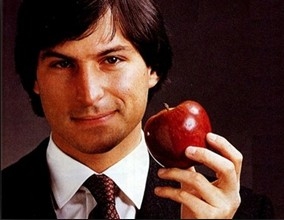There was, however, one programmer who was infusing the project with some life: Bill Atkinson. He was a doctoral student in neuroscience who had experimented with his fair share of acid. When he was asked to come work for Apple, he declined. But then Apple sent him a nonrefundable plane ticket, and he decided to use it and let Jobs try to persuade him. “We are inventing the future,” Jobs told him at the end of a three-hour pitch. “Think about surfing on the front edge of a wave. It’s really exhilarating. Now think about dog-paddling at the tail end of that wave. It wouldn’t be anywhere near as much fun. Come down here and make a dent in the universe.” Atkinson did.
然而,有一名叫比爾·阿特金森(BillAtkinson)的程序員給這個項目注入了一些活力。他是神經系統科學專業的博士生,也嘗試過不少迷幻劑。最初受邀加入蘋果的時候,他拒絕了。但是后來蘋果公司給他寄去一張不可退票的機票,于是他決定用上這張機票,讓喬布斯設法說服他。“我們正在創造未來,”喬布斯在長達3個小時的勸說接近尾聲時表示,“想象一下在海浪的最前端沖浪是什么感覺,一定很興奮刺激吧;再想象一下在浪的末尾學狗刨游泳,一點兒意思都沒有。來蘋果吧,你可以吸引全世界的目光。”阿特金森入伙了。
With his shaggy hair and droopy moustache that did not hide the animation in his face, Atkinson had some of Woz’s ingenuity along with Jobs’s passion for awesome products. His first job was to develop a program to track a stock portfolio by auto-dialing the Dow Jones service, getting quotes, then hanging up. “I had to create it fast because there was a magazine ad for the Apple II showing a hubby at the kitchen table looking at an Apple screen filled with graphs of stock prices, and his wife is beaming at him—but there wasn’t such a program, so I had to create one.” Next he created for the Apple II a version of Pascal, a high-level programming language. Jobs had resisted, thinking that BASIC was all the Apple II needed, but he told Atkinson, “Since you’re so passionate about it, I’ll give you six days to prove me wrong.” He did, and Jobs respected him ever after.
蓬松的頭發和長長的胡子并不能掩蓋阿特金森臉上的活力,他有著沃茲的創造天賦和喬布斯追求卓越產品的熱情。他的第一份工作是開發一個程序,該程序可以自動撥打道瓊斯的服務熱線,獲取報價,然后掛斷電話,以此來追蹤股票投資組合。“我必須盡快完成,因為一本雜志刊登的AppleII廣告上出現了這樣的場景:丈夫在廚房的餐桌旁盯著滿是股價圖表的AppleII屏幕,而妻子正對著他微笑——實際上根本就沒有這樣的程序,所以我必須創造一個。”接下來他又成功地將Pascal語言移植到AppleII上,這是一種髙級編程語言。喬布斯起初很抵制Pascal,因為他覺得AppleII有BASIC就足夠了,但他告訴阿特金森:“既然你對這個有這么大的熱情,我就給你6天時間來證明我是錯的。”阿特金森做到了,從此喬布斯對他很是尊敬。
By the fall of 1979 Apple was breeding three ponies to be potential successors to the Apple II workhorse. There was the ill-fated Apple III. There was the Lisa project, which was beginning to disappoint Jobs. And somewhere off Jobs’s radar screen, at least for the moment, there was a small skunkworks project for a low-cost machine that was being developed by a colorful employee named Jef Raskin, a former professor who had taught Bill Atkinson. Raskin’s goal was to make an inexpensive “computer for the masses” that would be like an appliance—a self-contained unit with computer, keyboard, monitor, and software all together—and have a graphical interface. He tried to turn his colleagues at Apple on to a cutting-edge research center, right in Palo Alto, that was pioneering such ideas.
到1979年的秋天,AppleII的潛在繼任者已經有了三種機型。有命運凄慘的AppleIII,還有已經開始讓喬布斯失望的麗薩項目。另外一個是喬布斯當時還不知道的一個小項目。這個項目致力于制造一款廉價的電腦,研發代號為“安妮”(Annie),開發者名叫杰夫·拉斯金(JefRaskin),他曾是個教授,還教過比爾·阿特金森。拉斯金的目棟是制造價格低廉、就像家用電器一樣的“大眾電腦”——整合了電腦、鍵盤、顯示器和軟件的全功能設備——并且擁有圖形界面。他試圖讓蘋果的同事們關注一家優秀的研究中心,這家研究中心就坐落在帕洛奧圖,是圖形界面技術的先驅。
Xerox PARC
施樂PARC
The Xerox Corporation’s Palo Alto Research Center, known as Xerox PARC, had been established in 1970 to create a spawning ground for digital ideas. It was safely located, for better and for worse, three thousand miles from the commercial pressures of Xerox corporate headquarters in Connecticut. Among its visionaries was the scientist Alan Kay, who had two great maxims that Jobs embraced: “The best way to predict the future is to invent it” and “People who are serious about software should make their own hardware.” Kay pushed the vision of a small personal computer, dubbed the “Dynabook,” that would be easy enough for children to use. So Xerox PARC’s engineers began to develop user-friendly graphics that could replace all of the command lines and DOS prompts that made computer screens intimidating. The metaphor they came up with was that of a desktop. The screen could have many documents and folders on it, and you could use a mouse to point and click on the one you wanted to use.
施樂公司的帕洛奧圖研究中心(PaloAltoResearchCenter)——常被叫做“施樂PARC”——成立于1970年,目的是為數字領域的創想提供成長環境。這里距離康涅狄格州的施樂公司總部3000英里,無論是好是壞,都脫離了那里的商業壓力。工作在這里的諸多夢想家中,有一位叫做艾倫·凱(AlanKay)的科學家,他的兩句格言深得喬布斯認同:“預見未來最好的方式就是親手創造未來”以及“對待軟件嚴肅認真的人,應該制造自己專屬的硬件”。凱推出了小型個人電腦的理念,他稱之為“動態筆記本”(Dynabook),使用簡便,即便是小孩子也能輕松操作。于是,施樂MRC的工程師們開始研發友好的用戶圖形界面,以取代電腦屏幕上那些拒人于千里之外的命令行和DOS提示符。他們想到,可以把桌面的概念應用到屏幕上。屏幕上會有很多文件和文件夾,用戶可以使用鼠標指向并點擊自己想要使用的內容。
This graphical user interface—or GUI, pronounced “gooey”—was facilitated by another concept pioneered at Xerox PARC: bitmapping. Until then, most computers were character-based. You would type a character on a keyboard, and the computer would generate that character on the screen, usually in glowing greenish phosphor against a dark background. Since there were a limited number of letters, numerals, and symbols, it didn’t take a whole lot of computer code or processing power to accomplish this. In a bitmap system, on the other hand, each and every pixel on the screen is controlled by bits in the computer’s memory. To render something on the screen, such as a letter, the computer has to tell each pixel to be light or dark or, in the case of color displays, what color to be. This uses a lot of computing power, but it permits gorgeous graphics, fonts, and gee-whiz screen displays.
圖形用戶界面——也就是GUI——的發展,也受到了當時施樂PARC另一個先鋒概念“位圖顯示”的推動。那個時候,大多數電腦還是基于字符的。你在鍵盤上輸入一個字符,計算機就會在屏幕上顯示那個字符,通常是熒光綠色的字符襯上深色的背景。因為字母、數字、符號的數量是有限的,所以這樣的顯示方式并不需要大量的電腦代碼或是很強的處理器性能。位圖顯示則相反,屏幕上的每一個像素都是由電腦內存控制的。要在屏幕上顯示某些內容——比如一個字母——電腦就要控制每個像素的明暗,如果是彩色顯示的話,則要控制每個像素的顏色。這會占用大量的系統資源,但是能夠支持炫麗的圖像、字體和驚人的顯本效果。











